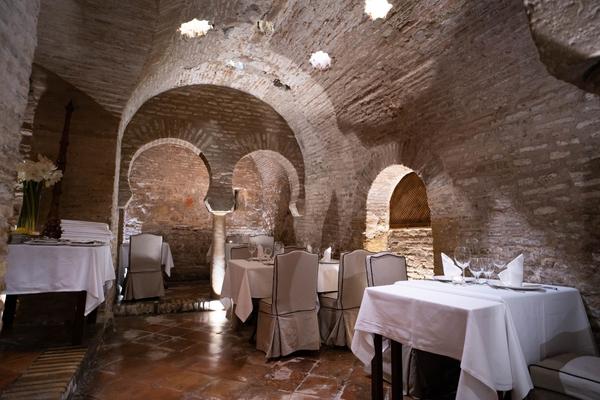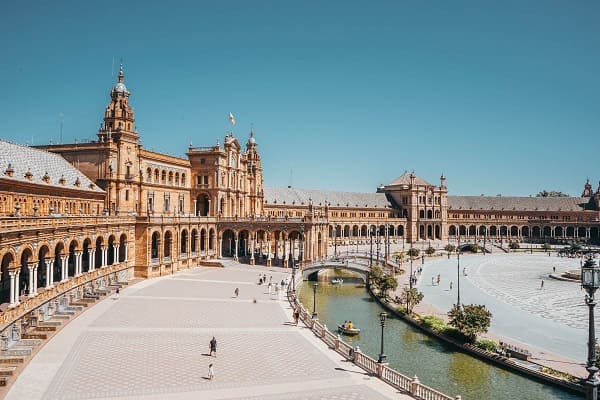In this entry we tell you the secrets of the Santa Cruz neighborhood in Seville, one of the most important neighborhoods of the 18th century. Its history is full of legends, such as that of the bandit Juan el Tempranillo, and curiosities, such as the fact that it was the most populated neighborhood in the city in the 18th century.
The Santa Cruz Seville neighborhood is home to a lot of history and numerous curiosities. This area is located in the historic center of Seville, right next to the Alcazar, the Cathedral and the Giralda. Its narrow, cobbled streets are a labyrinth in which it is easy to get lost.
In the Santa Cruz neighborhood we can find numerous monuments, buildings and places of interest, such as the Holy Cross Church, the Plaza Alfaro (where the monument to Don Juan Alfaro is located), the Colegio de San Bartolomé (where Brother Antonio Machado studied), the Pilate's House or several Arab baths from the Islamic era.
We can also visit some of the best restaurants in Seville, such as the famous San Marco Santa Cruz restaurant, located in one of these preserved Arab baths.
The Santa Cruz neighborhood is a very popular place among tourists, but also very loved by Sevillians, who consider it one of the most typical, authentic and essential neighborhoods in the city.
Santa Cruz neighborhood of Seville
The Santa Cruz neighborhood is one of the most emblematic places in Seville. With a history dating back to medieval times, the neighborhood has witnessed many important events in the city. Over the centuries, the neighborhood has changed a lot, but it continues to respect and maintain the essence of what it once was.
In the Santa Cruz neighborhood is the Seville Cathedral, one of the most visited monuments in the city. The Cathedral is a jewel of Gothic art and houses the tomb of the famous explorer Christopher Columbus. It is also worth visiting the Alcázar, another historical monument located in the neighborhood. The Alcázar is a royal palace, built by the Catholic Monarchs and today used as the official residence of the King of Spain.
History of the Santa Cruz Seville neighborhood
The Santa Cruz Seville neighborhood: history and curiosities. The Santa Cruz neighborhood in Seville has a rich and extensive history. Santa Cruz was the first Jewish neighborhood in Seville, and is known for its intimate atmosphere and narrow streets. Over the centuries, the neighborhood has witnessed many historical events, such as the Spanish Civil War in 1936. Today, Santa Cruz is a lively, multicultural neighborhood that attracts tourists from all over the world.
The Santa Cruz neighborhood is located in the old town of Seville, near the Cathedral and the Alcázar. Built in the 12th century, it became the city's first Jewish settlement. Over the years, it expanded and housed a growing Jewish community. In 1492, the Jews were expelled from Spain and emigrated to other countries. However, some Jews stayed in Spain and became converts. These converts were known as marranos and lived secretly as Christians.
In the mid-16th century, the Santa Cruz neighborhood was a wealthy neighborhood. Many noble families lived there and there were numerous palaces and mansions. In the 17th century, the neighborhood experienced a decline due to the plague and the War of the Spanish Succession. At the end of the 18th century, the neighborhood began to recover and became a cultural and artistic center. In the 19th century, Santa Cruz witnessed many historical events, such as the Spanish War of Independence and the Civil War.
In 1936, during the Civil War, the neighborhood was bombed by Franco's troops. Many buildings were destroyed and many people died. After the war, the neighborhood was abandoned and in ruins. However, the neighborhood has been rehabilitated and today it is a completely renovated and preserved place.
Curiosities
Known for its narrow cobbled streets, stately homes and garden squares, the neighborhood offers a unique atmosphere in the historic center of Seville.
Throughout all the alleys that make up the neighborhood, you can see circular shapes on the walls. They are mill wheels that fell into disuse and were reused by the builders of the 16th century to reinforce and protect the walls of the buildings at the height of the axles of the carts, thus preventing damage to the buildings.
That is to say, it was a practical solution to prevent the facades of the stately homes from being worn down by the continuous traffic of carriages, which with their axle guards filed and hit the walls due to the continuous friction.
One of the curiosities of the neighborhood is that it is home to the house where Diego Velázquez, one of the great painters of the 16th century, was born. The palace-house is located on Santa María La Blanca street, right next to the Church of Santa Cruz. Another interesting place is the Casa de Pilatos, a 16th century palace that today houses the Museum of Fine Arts.
The Santa Cruz neighborhood is one of the most visited places in Seville, and it is also a good place for shopping. In the narrow streets of the neighborhood you can find shops of all kinds, from souvenir shops to antique shops and art galleries.
Plaza de Santa Cruz is one of the most beautiful squares in the neighborhood, and it is also a good place to have a coffee or a soft drink at one of the open-air bars. You can also visit the Church of Santa Cruz, which dates back to the 16th century, and the Convent of Santa Cruz, founded in the 13th century.
Conclusion
After reading this article, do you dare to visit the Santa Cruz neighborhood in Seville? You will surely be pleasantly surprised. Don't forget to go through Mesón del Moro street and reserve a table at the San Marco Santa Cruz restaurant. And if you have the chance, don't miss the flamenco show at Guitar House!






